Please Click On Any Picture for a Larger Version
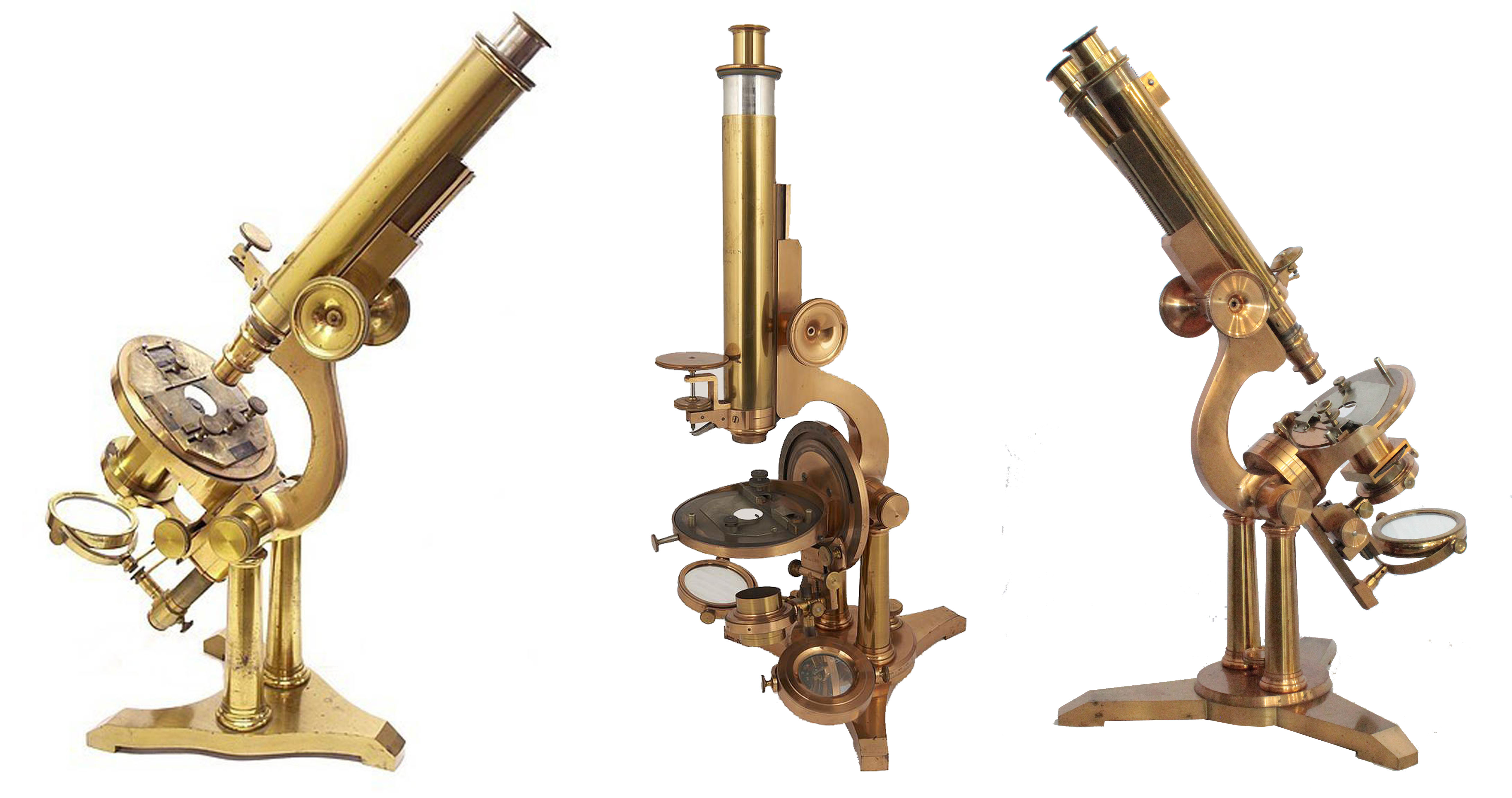
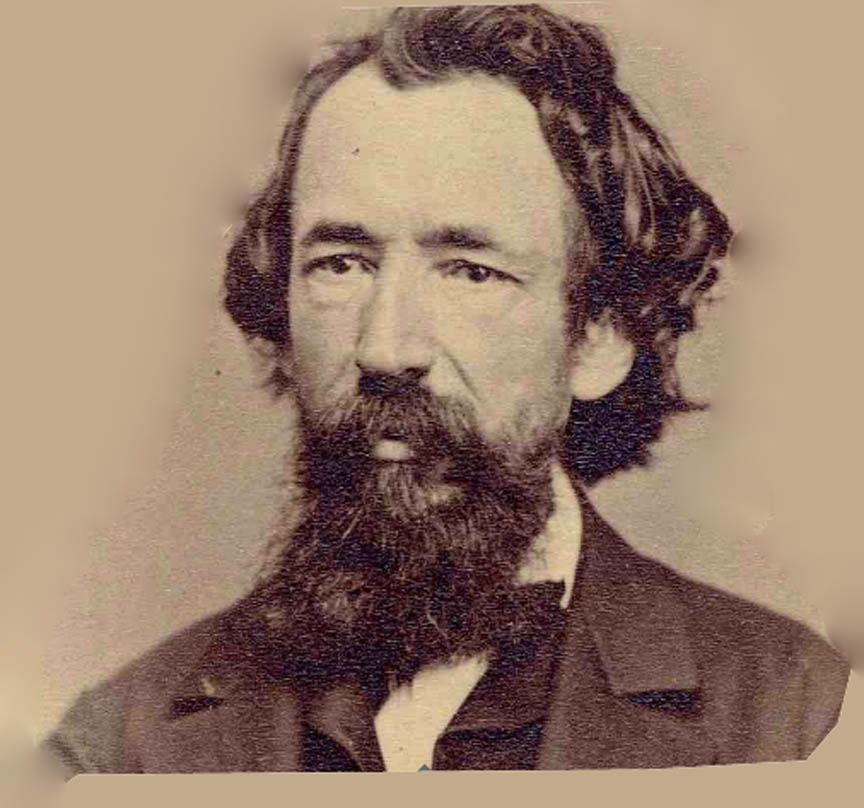 Robert Tolles(left) was a remarkable man who grew up without means. He could not afford to attend college, but instead when old enough, set out to find a suitable employment. On his journey he happened to pass through Canastota, New York and came across the workshop of the famous and very talented Charles Spencer. He immediately decided this was the profession for him and he stayed as an apprentice and then workman for Spencer, spending about fourteen years with Spencer.
Robert Tolles(left) was a remarkable man who grew up without means. He could not afford to attend college, but instead when old enough, set out to find a suitable employment. On his journey he happened to pass through Canastota, New York and came across the workshop of the famous and very talented Charles Spencer. He immediately decided this was the profession for him and he stayed as an apprentice and then workman for Spencer, spending about fourteen years with Spencer.Tolles First Class Trunnion Microscopeand also
Smith's Inverted Microscope for Chemists. The 1873 BOW catalog with Stoddard as agent, notes that the BOW also sold microscopes by Zentmayer, objectives by Wales and the Bulloch self-centering slide-ringing turntable.
second class*microscope) The 'C' (The 'B' with sector rotation to the substage)
Botanical Microscopeof unusual construction signed by Dalton, and an inverted Tolles Chemical Microscope after Lawrence Smith. There are three wooden microscope models attributed to Dalton at Harvard University. One is the prototype for the 'A' stand, the other two are clearly one of a kind wooden instruments. Because no illustrated catalog of Dalton stands per se seems to exist, it is difficult to know what Dalton actually offered as standard instruments. Very few microscopes with Dalton's signature are known, and even then, the signature is hidden on at least his
A standin this collection. For now, as far as Dalton's models are concerned, all we can do is review the examples that are currently(2021) known. It should also be noted that Dalton also sold microscopes by other makers including Zentmayer and Bausch & Lomb of the U.S.A. as well as Leitz and Fuess, both of Germany. In these instances, Dalton's trade card is to be found inside the door of the cabinet in which the instruments were sold. For more about C.X Dalton please see the History Section of the page about the "A" stand constructed by Dalton.
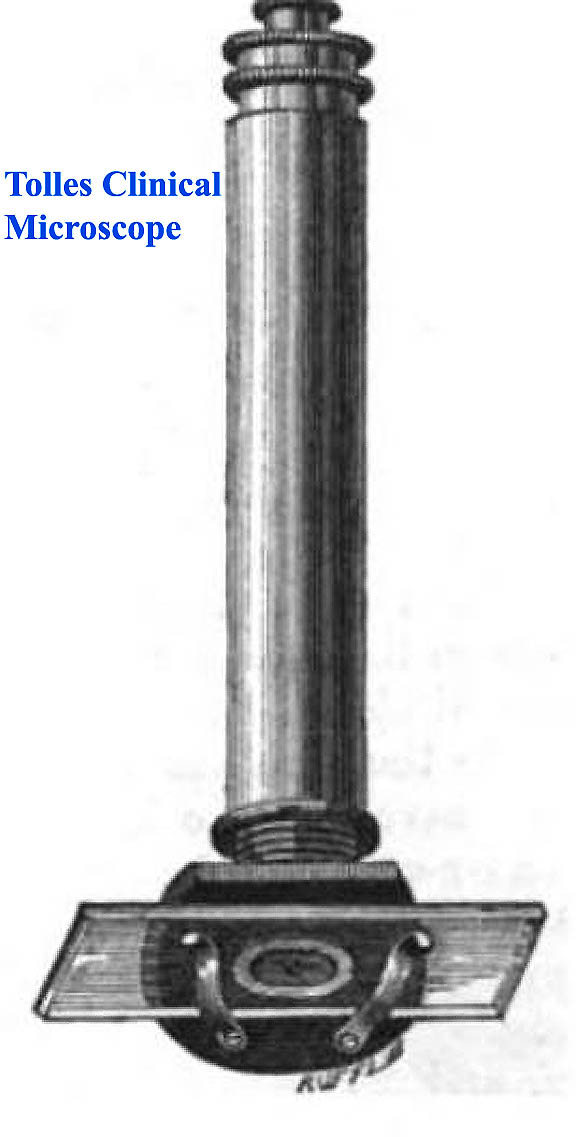
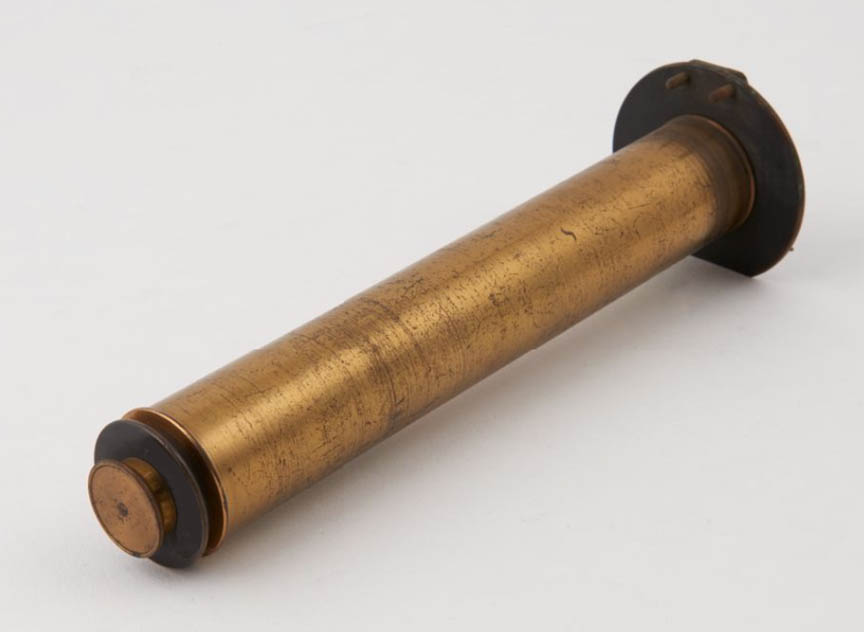 Tolles 'Pocket Microscope' also called his 'Clinical Microscope' was basically in the form of what most makers would call a 'demonstration microscope' and consisted of only a stage and focusing optical tube to be hand-held. Coarse focusing was by sliding the outer tube and fine focus was by turning the threaded inner tube at the bottom near the objective.
Tolles 'Pocket Microscope' also called his 'Clinical Microscope' was basically in the form of what most makers would call a 'demonstration microscope' and consisted of only a stage and focusing optical tube to be hand-held. Coarse focusing was by sliding the outer tube and fine focus was by turning the threaded inner tube at the bottom near the objective. PROFESSOR'S MICROSCOPE:
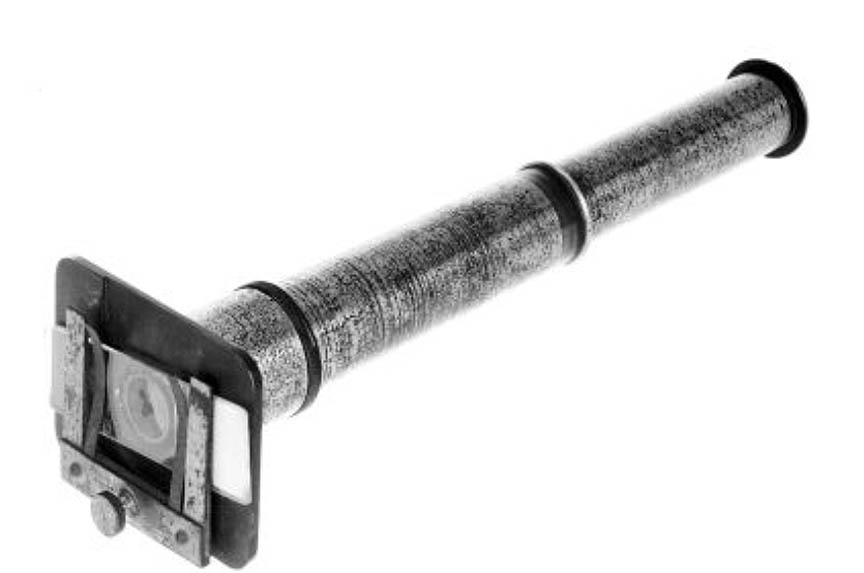 This was similar to the pocket microscope, except it provided a mechanism to lock the slide in place so that the object being studied did not shift as the microscope was passed from student to student.
This was similar to the pocket microscope, except it provided a mechanism to lock the slide in place so that the object being studied did not shift as the microscope was passed from student to student.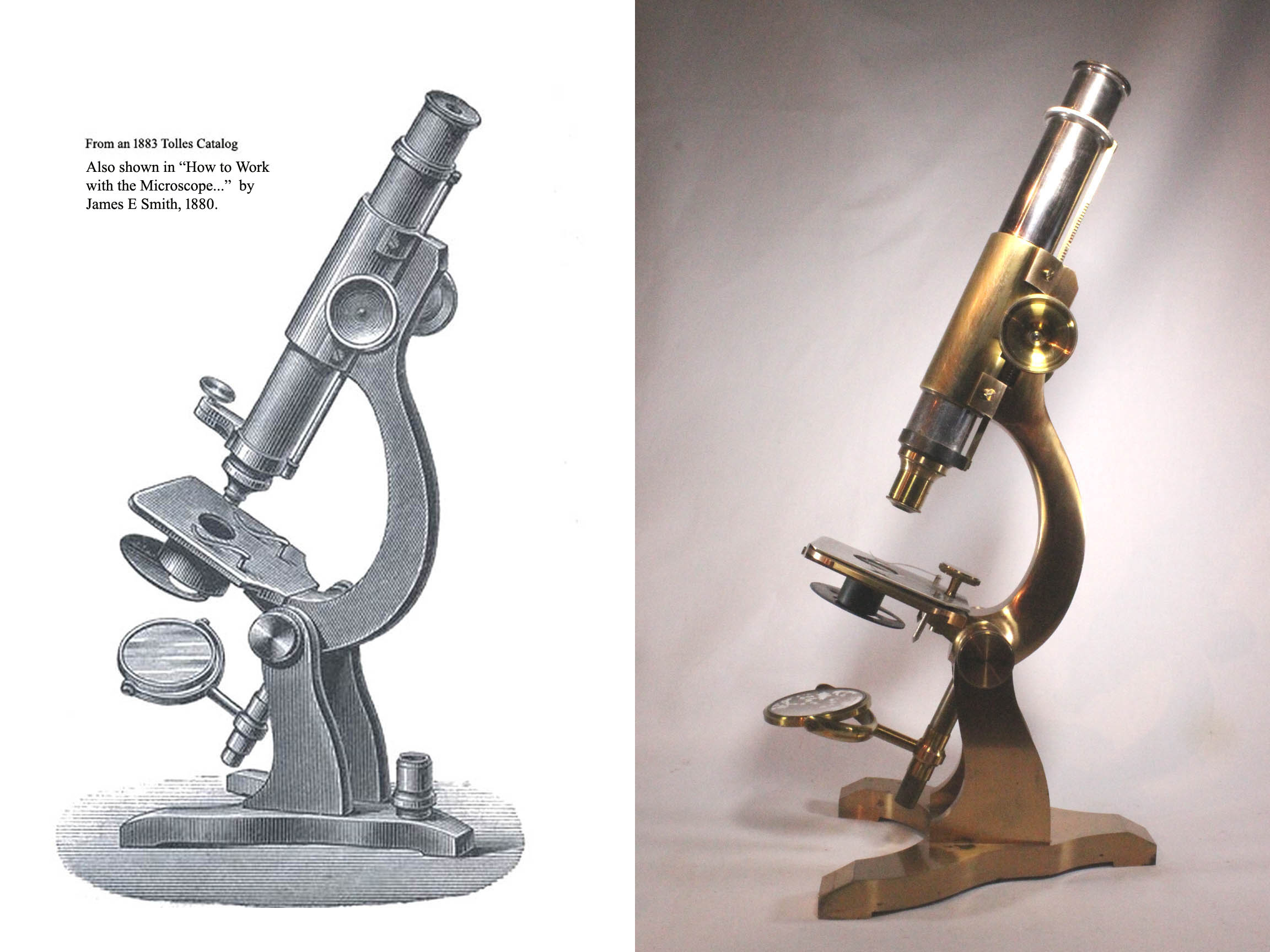
2nd qualityobjective.
STUDENT SIZEMICROSCOPE by C.X. DALTON:
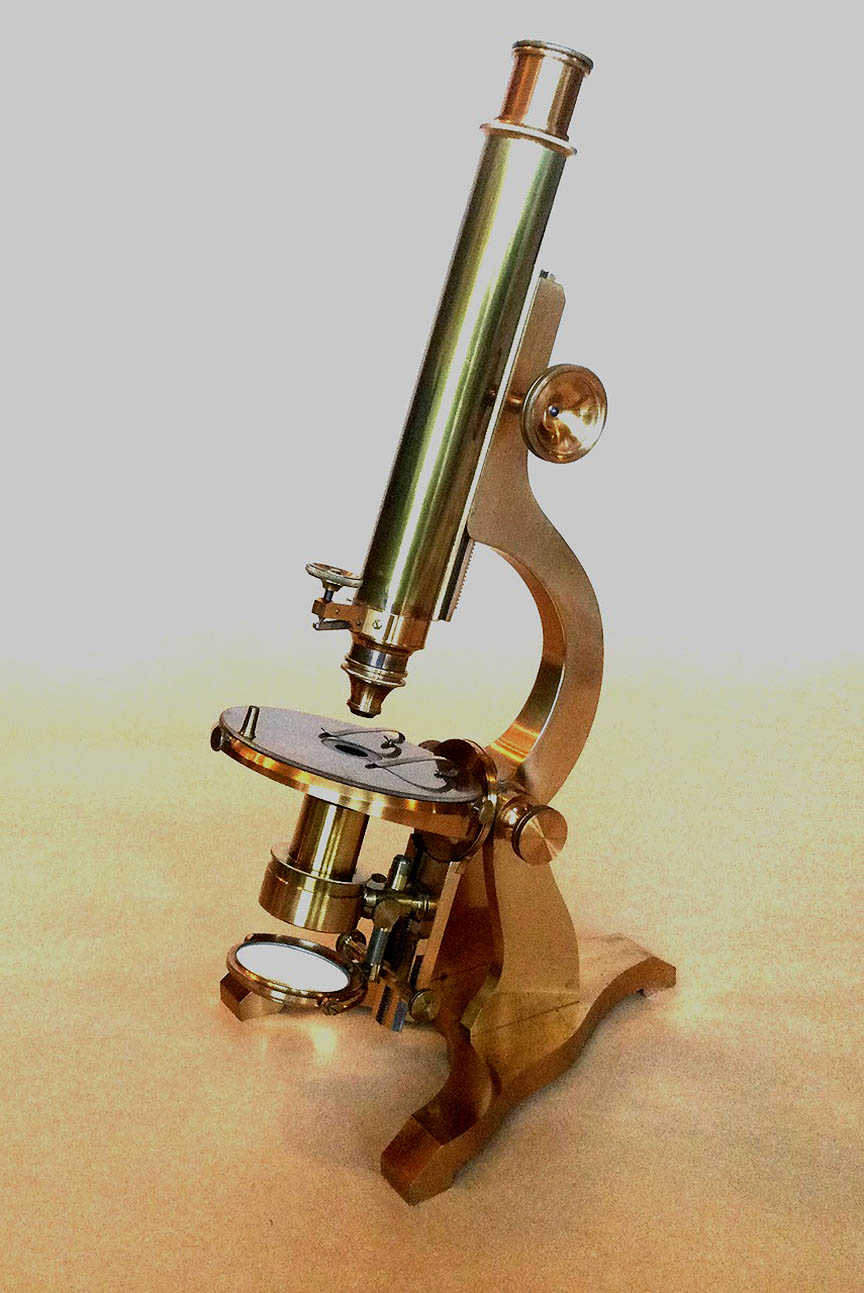 Although C.X. Dalton had done much of the brasswork for Tolles, after he took over the Boston Optical Works he produced some stands that shared some features of Tolles designs but also changed or customized the designs. This is an example of such a stand, images of which were kindly provided by its former owner, Bill Burnett and its current owner, Tom Schwan. The author is also grateful to Tom Schwan for assisting with this section about this microscope. This stand has the classic BOW tapering bowed limb. In common with the Tolles Student model, this stand arises on two flat uprights. Also in common with the student model is the fact that there is a simple stage, not any form of mechanical stage as is found on the earlier and much larger Tolles
Although C.X. Dalton had done much of the brasswork for Tolles, after he took over the Boston Optical Works he produced some stands that shared some features of Tolles designs but also changed or customized the designs. This is an example of such a stand, images of which were kindly provided by its former owner, Bill Burnett and its current owner, Tom Schwan. The author is also grateful to Tom Schwan for assisting with this section about this microscope. This stand has the classic BOW tapering bowed limb. In common with the Tolles Student model, this stand arises on two flat uprights. Also in common with the student model is the fact that there is a simple stage, not any form of mechanical stage as is found on the earlier and much larger Tolles Bstands. But instead of being square, the stage on this microscope is round. The main differences between this Dalton stand and the Tolles Student model, are the addition of a swinging mirror tailpiece, and a rack & pinion focusing substage. It has the same narrow tube as the Student model, not the wider diameter of the B stand. As is shown in the table and image below, this model is only slightly larger than the Tolles student stand and slightly heavier than the Tolles student,but much lighter and smaller than a B stand. Its proportions are not close to any of Tolles known B stands or the A stand. Its swinging substage is nothing like the more sophisticated one on the Tolles-Blackham microscope(shown below) and much more like the simple swinging substage of the Beck
Ideal ModelThis then represents Dalton's modified version of a stand very much like the Tolles Student microscope, and of only slightly larger proportions. It is more like the Tolles Student Model than the larger and much heavier
B Stand.
| MODEL | HEIGHT(inches)* | WEIGHT(lb) |
| Tolles Student | 15.25" | 8.4 lb |
| Dalton Student | 16.25" | 9.8 lb |
| B stand | 19.25" | 17.6 lb |
| A Stand | 18.25" | 18.5 lb |
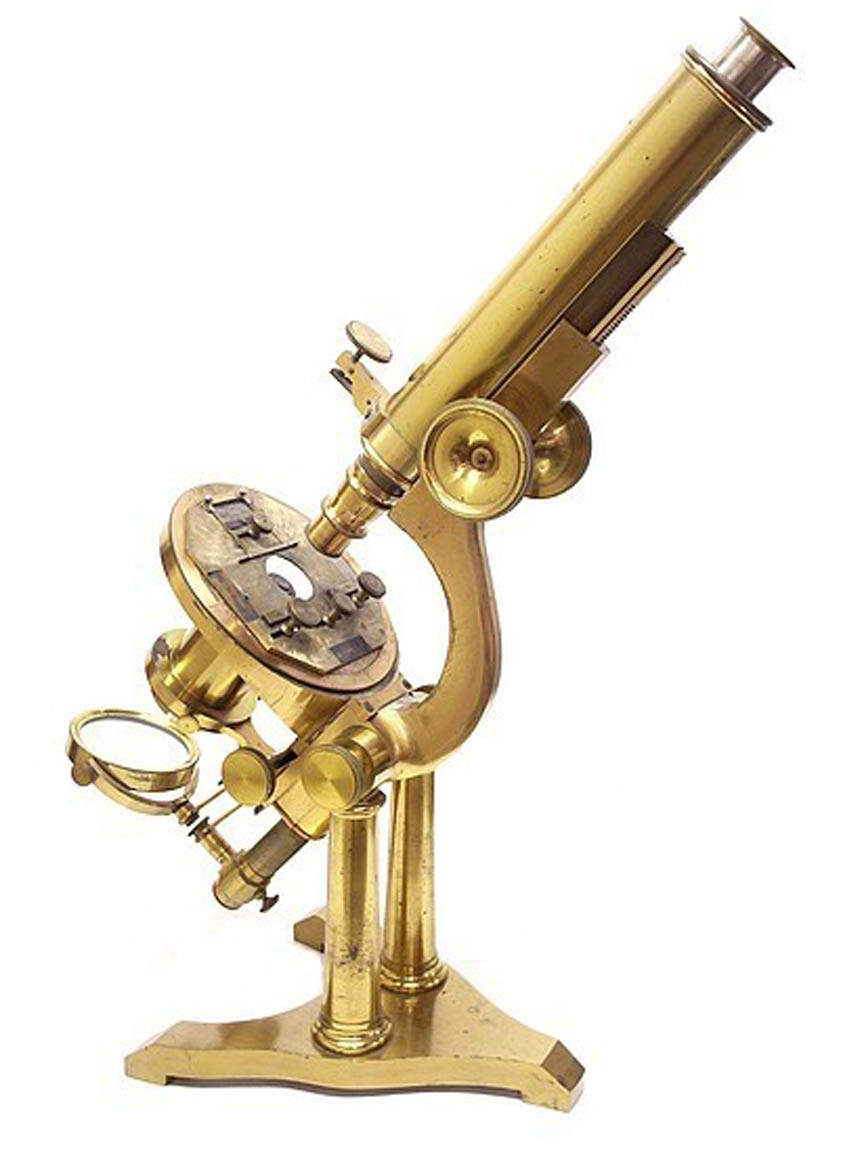 :
The 'B' stand was Tolles' most popular
:
The 'B' stand was Tolles' most popular second class* microscope. It was extremely well made and was used by many for work that was very demanding, attesting to its quality. It was often sold with Tolles best objectives, not the 2nd quality objectives supplied with his student microscopes. It weighs about 14 pounds and sits on a modified Y-shaped foot with round pillars supporting the limb. It has a 5 inch diameter mechanical stage that could be rotated. It came in a dark walnut cabinet. Although it did not come standard with a tilting substage, an attachment to the tailpiece of this stand would allow very oblique illumination with a microscope objective used as a condenser. The author is grateful to Allan Wissner for allowing me to use his images of this microscope. Tolles B stands are quite uncommonly found these days and most are coveted by their owners, often coming well equipped with many high quality objectives.
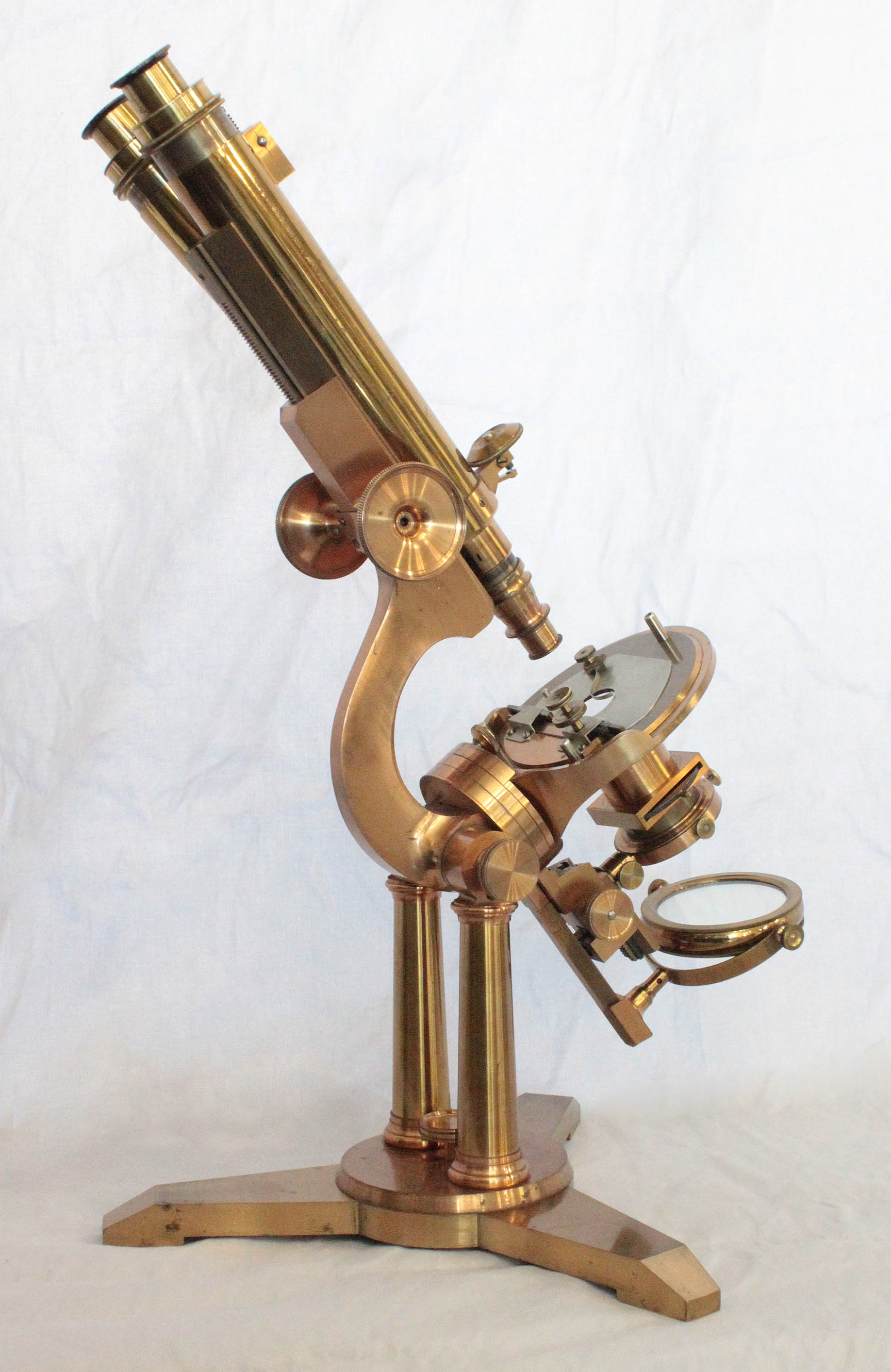 The A stand was Tolles' and Dalton's biggest and best microscope. This example was made by Tolles' Foreman, Charles X Dalton in 1886, soon after Tolles had passed away. Dalton advertised himself featuring Tolles' microscopes. It features binocular tubes, short lever nosepiece fine focus, swinging substage with rack and pinion focusing, a separate swinging tailpiece for the mirror, centering for the condenser and an equilateral flat tripod foot with rotation for the stand which can be locked. The stage is Tolles
The A stand was Tolles' and Dalton's biggest and best microscope. This example was made by Tolles' Foreman, Charles X Dalton in 1886, soon after Tolles had passed away. Dalton advertised himself featuring Tolles' microscopes. It features binocular tubes, short lever nosepiece fine focus, swinging substage with rack and pinion focusing, a separate swinging tailpiece for the mirror, centering for the condenser and an equilateral flat tripod foot with rotation for the stand which can be locked. The stage is Tolles thin type,and can rotate completely, featuring a concentrically controlled Bulloch-type mechanical stage. As of the date of this writing, the A stand is an extremely rare instrument, and the author knows of no other extant example made of metal. The reason for the rarity is simple. This stand cost nearly one third more than the B stand, shown above, and the B stand is an extremely well made microscope. It was available with the most important features of the A stand. The main difference was the type of foot, and the fact that the A was slightly larger and 25% heavier than the B. In keeping with this, the stage had a 6 inch diameter as opposed to the 5 inch diameter stage of the B stand-see below. Lastly, at least in this example, the substage could be tilted to any angle, making the best use of the thin stage thus allowing the most oblique illumination. The mechanism of tilting or swinging the substage is clearly a copy of the type devised by Zentmayer and especially Bulloch who first constructed it with a separate swinging tailpiece for the mirror which could be swung differently than the substage if desired.
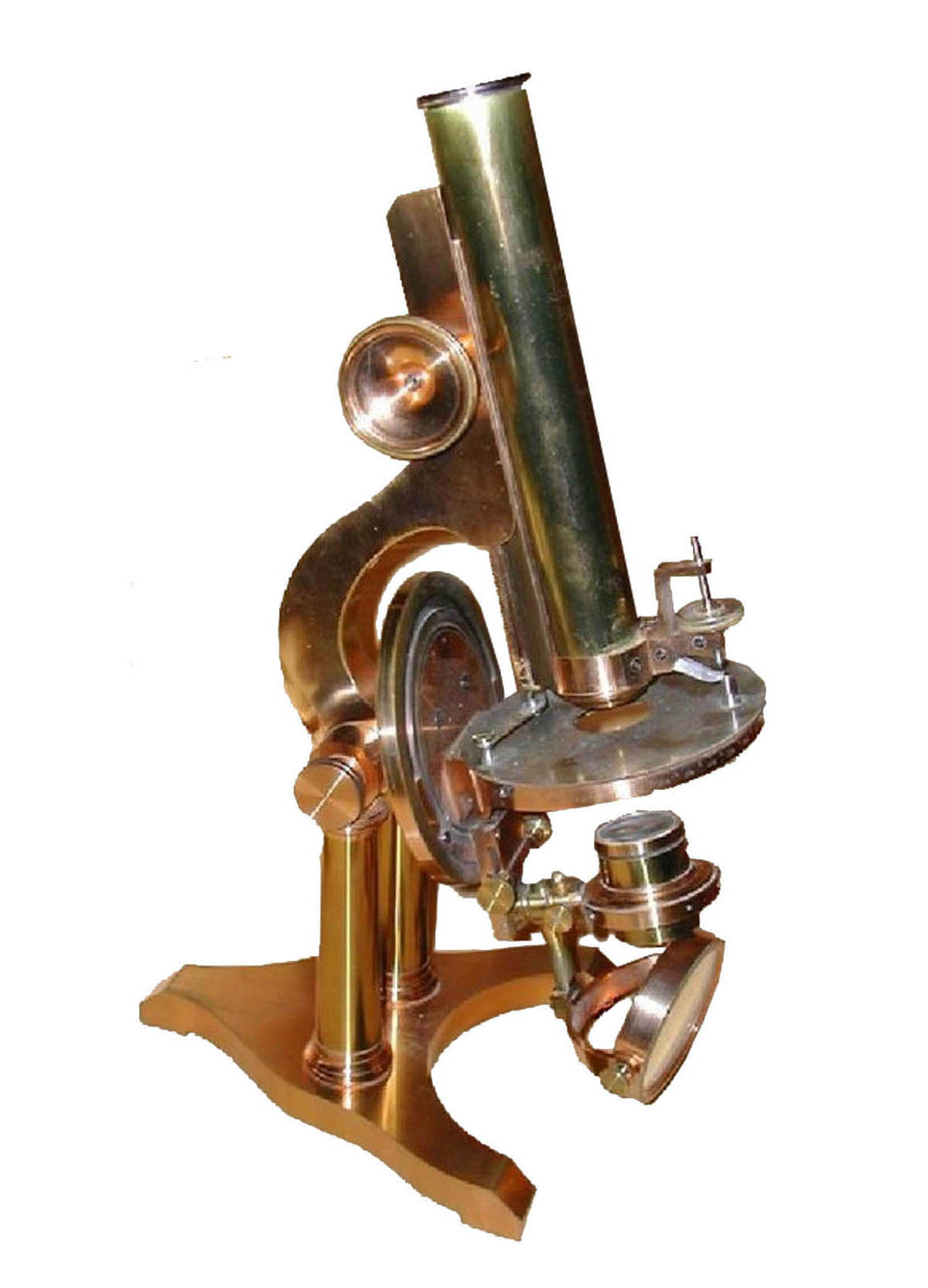
 In 1878, the first version of the
In 1878, the first version of the Tolles-Blackman microscope(left) was reported in the JRMS and it was first pictured in the Journal in 1880. The example from 1878 was reportedly owned by Mayall. In 1880 it is reported that it was first made for Dr George Blackham, MD, FRMS. Blackham was a famous microscopist, an early member of the American Microscopical Society(AMS), and good friend of both Charles Spencer and Robert Tolles; he was the author of Tolles' obituary published in 1884 in the AMS journal, Proceedings of the American Society of Microscopists. Dr Blackham was the author of a famous publication, read before the Microscopical Congress in 1878 and published as a booklet in 1880 entitled On the Angular Aperture of Objectives for the Microscope. The Tolles-Blackham(T-B) microscope had the same foot as the 'B' stand and it may be the microscope referred to in the BOW catalogs as the 'C' stand. The microscope on the right is a later version of the T-B microscope reported in the JRMS of 1881. These microscopes were equipped with the Tolles sector or
patent radial armfor the substage, which
carries the illumination above the stage, and measures the angle of incidence of lightabove or below the stage. This is a mechanism similar to many other microscopes of the time, popular when very oblique lighting was in vogue and thought to be a way of increasing resolution. This was sometimes even applied to third class microscopes like the Beck
Ideal Microscope, and as noted above, a simple version of swinging substage is found on the Dalton Student stand pictured above.
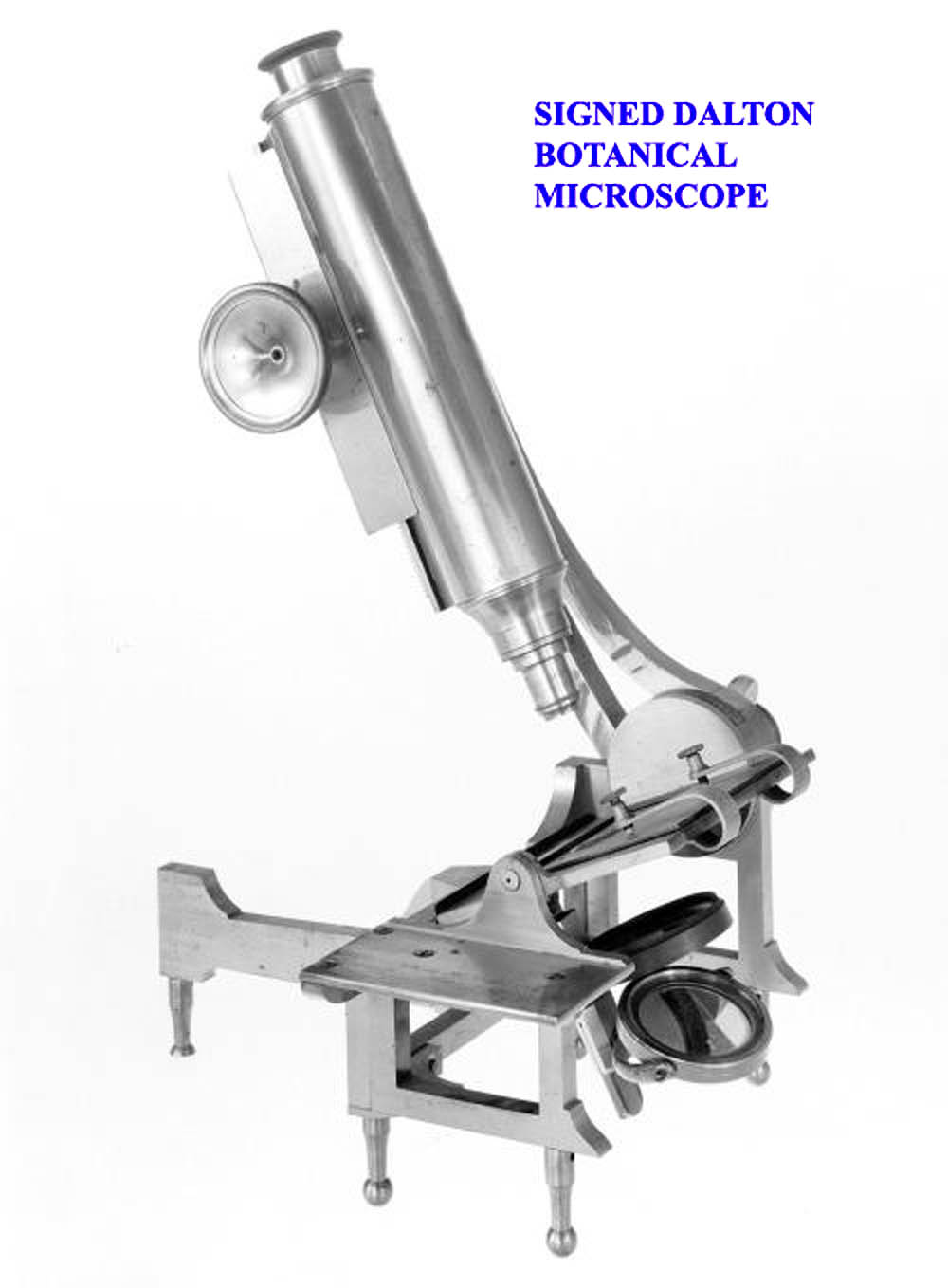
botanicaltype in the Harvard records, though why this is stated is a mystery to this author. It is signed by Dalton and the curator noted that it is constructed to a very high standard. It was specially made for F.H. Peabody in 1890. Peabody was a prominent banker, member of the Boston Natural History Society, and a member of the New England Botanical Club.
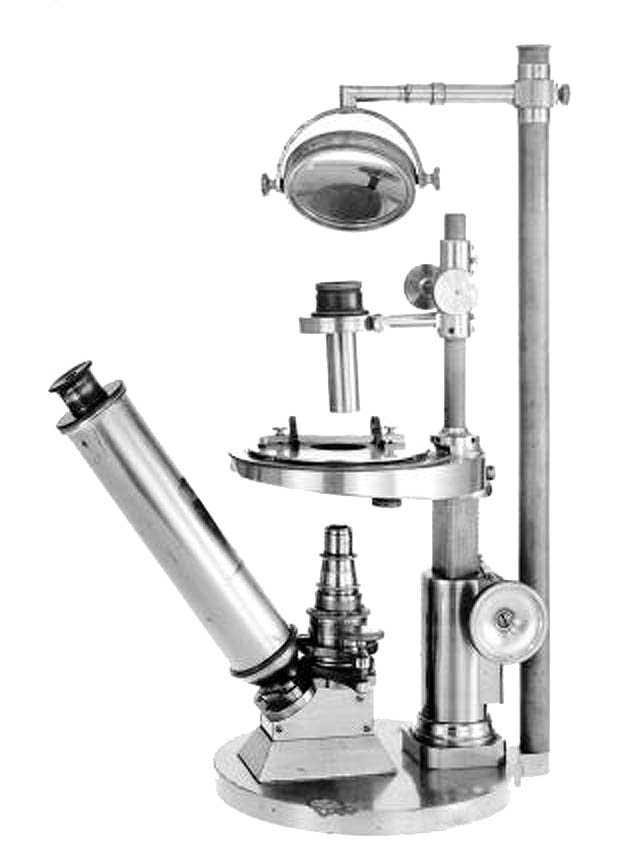
second classinstruments by convention, they were for most purposes, constructed with such high quality they were equal to, or better than, any
first classinstrument of the time.